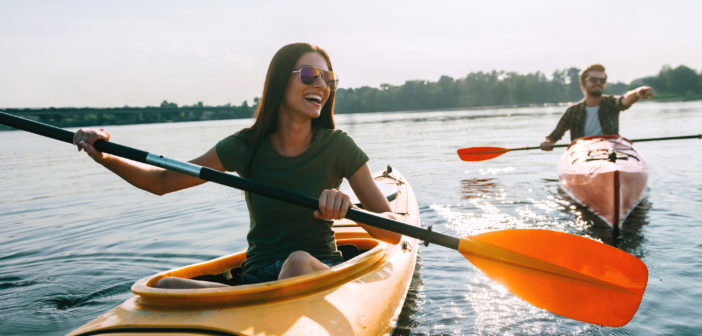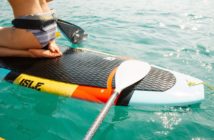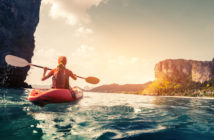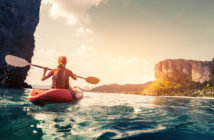If you’re looking for kayaking for beginners information, you’ve come to the right place.
You’re not the only one.
Kayaking has grown to become a favorite pastime for millions of people, with more people discovering kayaking every year.
Kayaking has grown from 6.1 million participants in 2006 to close to 16 million in 2016.
It’s not hard to understand why. Kayaking offers an opportunity to stay cool in the summer, enjoy nature, get fit, or go fishing or camping with the kayak.
Keep reading if you want to learn the top tips to get started and get out on the water.
1. Types of Kayaks
One of the first things you should know about kayaking are the different types of kayaks.
They can hold 1-3 people and for different purposes. Some kayaks are specifically designed for recreation, touring, surfing, whitewater, racing, or sea. Kayaks can also be hybrids, which can combine aspects of kayaks and canoes or stand up paddle boards.
Kayaks come at different price points. They consist of different materials, such as plastic, kevlar, or PVC for inflatable kayaks.
Plastic kayaks are the least expensive, while Kevlar kayaks are the most expensive.
2. Kayak Paddles
When you’re looking at kayak paddles, you need to know three things:
- Paddle length
- Paddle Materials
- Paddle Features
The paddle length depends on the type of kayak and your height. If you’re a beginner, you’re going to start off in a recreational kayak, which is wide for extra stability. Touring and racing kayaks go faster in the water and are narrower.
You need to make sure that the paddle you use will be long enough to reach the water, so it has to be long enough to overcome the width of the kayak.
Paddles are usually made of aluminum, fiberglass or carbon. Aluminum more of an introductory paddle while carbon is a higher end paddle that’s durable and light.
3. Lifejackets & Safety Equipment
Even in the most tranquil environments, kayaking can pose some risks. There are 3 to 6 injuries per 100,000 boating days.
On the water, you need to prepare for anything. You’ll need to start with a life jacket that’s fitted properly. You can also have a first aid kit, tow lines, knives to cut debris in emergencies, and helmets are other items to have on board.
4. How do You Launch a Kayak?
There are different scenarios to launch a kayak. You can start from a dock, in the water or on the beach.
Before you launch, you’ll want to run through your equipment to make sure you have your safety equipment and the kayak and paddles are in good working order.
Bring the kayak to the edge of the water. Hang onto the boat on both ends and bring the boat into the water just enough so it doesn’t float away.
Now, you’ll get on the boat. Keep your weight balanced on both sides of the kayak and step in the cockpit one foot at a time.
Once you’re in and settled, grab your paddle and take a couple of strokes to get clear land.
5. Getting In and Out of a Kayak
The trick to launching and landing a kayak is getting in and out of the kayak. If you’re launching from a dock, you’ll definitely need to learn this.
If you’re getting in from a dock, have a friend hold the kayak steady while you get in.
When you’re landing the kayak in a rocky area, get the kayak parallel to the shore and use your paddle to help you out of the kayak.
6. Paddling
Paddling starts with how you hold the paddle. Keep the paddle in both hands. Your hands should be slightly more than shoulder-width apart. The concave (inward curve) part of the blade should be facing you.
This will enable you to catch as much water as you can to propel the kayak.
7. Sit Right
Good posture is the foundation of a good paddling. It also reduces the risk of low back pain, because you’re using your core to hold yourself up.
Chronic injuries account for up to 40% of all kayaking injuries. These are mostly shoulder or wrist injuries due to overuse and poor form.
Your core is also where your power comes from when paddling.
In the boat, you should sit upright, with your torso at a 90-degree angle to your legs. Your feet can rest on the pegs at the end of the kayak, with a slight bend in the knees.
8. Keep Your Camera on a Short Strap
The thing about kayaking for beginners is that when you’re on the water for the first time, you want to capture every moment.
Have your camera or binoculars on a short strap so they’re close your body, accessible, and away from the water.
9. Have a Waterproof Bag
One of the biggest challenges for kayakers is keeping you and your belongings dry.
Experienced kayakers will have a spray skirt, which covers the opening of the kayak to keep water from getting in. Beginner kayakers shouldn’t use a spray skirt until you know how to take it off quickly in case you’re submerged underwater.
Since you’ll still need a way to keep your belongings dry, you should invest in a dry bag. It’s a nylon bag that has a waterproof coating that will keep everything nice and dry.
You never know what’s going to happen on the water. That’s why you’re always going to want to have a change of clothes handy.
10. Know What to Do in an Emergency
Out on the water, safety is the top priority.
When you’re learning how to kayak, one of the most important things you need to know is what to do in an emergency.
You need to learn how to handle situations like your boat capsizing and how to rescue yourself and others, whether they’re in your group or if you come across other kayakers who need help.
As a beginner, you should kayak with a group or with a certified instructor, who can show you the different types of emergencies and how to handle them.
Kayaking for Beginners
Kayaking has many benefits. One moment, you’re enjoying a stress-free, tranquil environment and the next you’re using your entire body to propel your kayak.
You’re reducing stress and building up fitness at the same time.
Kayaking for beginners can be overwhelming because there is so much to learn. The key is to get a good guide or mentor who can show you the basics and keep you and your kayaking companions safe.
For more great tips on learning how to kayak, check out this in-depth guide.




